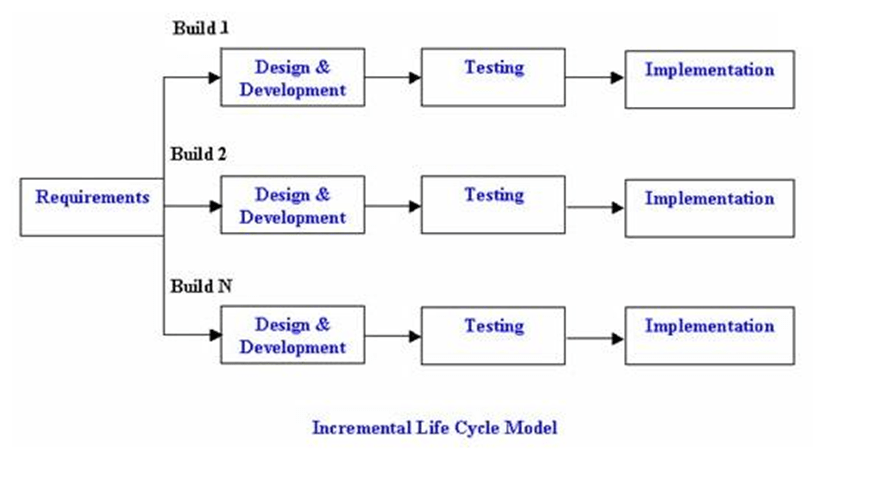Incremental software Process Model
-incremental model -incremental model in software engineering -incremental model diagram -incremental model example -incremental model phase -Software engineering concept -Software engineering MCQ -Software engineering Interview Question –Software engineering question paper –free course online –past papers -final year projects for computer science with source code -semester project ideas -computer programming -computer science interview questions- tutorial –cui
- In incremental model the whole requirement is divided into various builds.
- Multiple development cycles take place here, making the life cycle a “multi-waterfall” cycle.
- Cycles are divided up into smaller, more easily managed modules.
- Each module passes through the requirements, design, implementation and testing phases.
- A working version of software is produced during the first module, so you have working software early on during the software life cycle.
- Each subsequent release of the module adds function to the previous release. The process continues till the complete system is achieved.

- The software is developed and delivered in small increments.
- In the case of the incremental model , the first increment that is delivered is the core product.
- The core product addresses the primary needs of the final product.
- It is evaluated and reviewed by the client.
The incremental model combines elements of the linear sequential model with the iterative philosophy of prototyping. As figure 2.5 shows, the incremental model applies linear sequences in a staggered fashion as calendar time progress. Each linear sequence produces as deliverable “increment” of the software. For example word processing software developed using the incremental paradigm might deliver basic file management, editing, and document production functions in the first increment; more sophisticated editing and document production capabilities in the second increment; spelling and grammar checking in the third increment; and advanced page layout capability in the fourth increment.
It should be noted that the process flow for any increment can incorporate the prototyping paradigm. When an incremental model is used, the first increment is often a core product. That is basic requirements are addressed, but many supplementary features,(some known, others unknown) remain undelivered. The core product is used by the customer(or undergoes detailed review). As a result of use and/or evaluation, a plan is developed for the next increment. The plan addresses the modification of the core product to better meet the needs of the customer and the delivery of additional features and functionality. This process is repeated following the delivery of each increment, until the complete product is produced. Early increments are “stripped down” versions of the final product but they do provide capability that serves the user and also provide a platform for evaluation by the user. Incremental development is particularly useful when staffing is unavailable for a complete implementation by the business deadline that has been established for the project. Early increments can be implemented with fewer people. If the core product is well received, then additional staff can be added to implement the next increment. In addition, increments can be planned to manage technical risks. For example, a major system might require the availability of new hardware that is under development and whose delivery date is uncertain. In might be possible to plan early increments in a way that avoids the use of this hardware, thereby enabling partial functionality to be delivered to end users without inordinate delay.
Incremental development is particularly useful when staffing is unavailable for a complete implementation by the business deadline that has been established for the project. Early increments can be implemented with fewer people. If the core product is well received, then additional staff can be
added to implement the next increment. In addition, increments can be planned to manage technical risks. For example, a major system might require the availability of new hardware that is under development and whose delivery date is uncertain. In might be possible to plan early increments in a way that avoids the use of this hardware, thereby enabling partial functionality to be delivered to end users without inordinate delay.
#incrementalmodel#incrementalmodelinsoftwareengineering#incrementalmodeldiagram#incrementalmodelexample#incrementalmodelphase#Softwareengineeringconcept#SoftwareengineeringMCQ#SoftwareengineeringInterviewQuestion#Softwareengineeringquestionpaper#freecourseonline#pastpapers#finalyearprojectsforcomputersciencewithsourcecode#semesterprojectideas#computerprogramming#computerscienceinterviewquestions#tutorial–cui
#courses #pastpaper #Finalyearproject #tutorial #cui #project #programming #computer science #computersciecnemcq’s #computerscienceinterviewquestion

